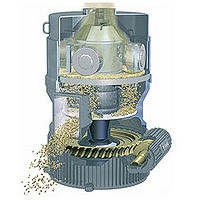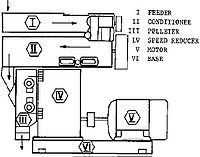Difference between revisions of "Pellet Mills"
(Created page with "Category:Particle Formation{{Knoppen}} <noinclude><!------------------------------------------------ * READ THIS FIRST * Only edit this page if you can improve the content. ...") |
PurplePen19 (talk | contribs) |
||
| Line 7: | Line 7: | ||
* Please start editing this page after the /noinclude | * Please start editing this page after the /noinclude | ||
* -------------------------------------------------></noinclude> | * -------------------------------------------------></noinclude> | ||
This | |||
[[File:Pellet Mills_1.jpg|thumb|200px|right|Pellet Mills]] | |||
[[File:Pellet Mills_2.jpg|thumb|200px|right|Pellet Mills Diagram]] | |||
'''Pellet Mills''' enables you to make your pellets or animal feed granules from your own material. The granulation unit can be used for granulating sawdust, straw, biomass, paper, or for the granulation of feed and fodder mixtures, etc. | |||
==Construction and Operation== | |||
In order to produce pellets (animal feed pellets, sawdust pellets, biomass pellets), raw materials are processed inside a pellet mill or pelleting press. Inside the pellet mill the most important part for producing the formed pellets is the pellet die. | |||
Inside the pellet mill is the pellet die, either a ring die or a flat die. The raw material is fed into the compression chamber, where pellet rolls press/roll the raw material through the small holes of the pellet die. Out of the outerside of the pellet dies come out the long strands of pellets, which are then cut by a knife to give the finished pellets out of the output chute. | |||
==Common Types== | |||
===Standard Pellet Mill=== | |||
The first type of pellet mill is a Standard Pellet Mill, most frequently used for the pelletizing and production of pelleted poultry feed and other animal feeds. | |||
===Aqua feed Pellet Mill=== | |||
The second type of pellet mill is for the production of aquatic feeds - aquafeed. These include both fish feed and shrimpfeed. This type differs in having additioner conditioning tubes. | |||
===Flat Die Pellet Mill=== | |||
The third type of pellet mill is one that utilizes a flat die. This type of pellet mill is used to produce both feeds and wood pellets. | |||
===Biomass Pellet Mill=== | |||
The fourth type of pellet mill is a Biomass Pellet Mill. It is a heavy duty pellet mill used for the pelleting of waste, wood, and other biomass. | |||
==Process== | |||
The process of pelleting consists of forcing a soft feed through holes in a metal die plate to form compacted pellets which are then cut to a pre-determined size. The machinery which has been developed for this purpose is now very diverse in design and there is much controversy between different equipment manufacturers as to which type is the most effective. Pelleting is a key to the production of high quality nutrional feeds as they ensure that the feed formulation is in the correct quantities for all that eat them. Each bite of a pellet will have the same designed formulation ensuring all the stock are feed as intended. | |||
Most pellet mills now have one or more conditioning units mounted above them where liquids such as water and molasses can be added to improve pelletability. The water is sometimes added in the form of steam which softens the feed and partially gelatinises the starch content of the ingredients, resulting in firmer (and for aquafeed more water stable) pellets. | |||
From the conditioner, the feed falls into the centre of the pelleter itself. In the pelleter two or more rollers and feed ploughs push the material through the holes of the die plate (see illustration below). A photograph of a die plate is shown in the photo above right: | |||
Usually the die plate itself rotates, and on its outer-side stationary knives cut the pellets to a pre-set length. From there, they are transferred to a cooler/drier to remove the heat which is generated during the pelleting process or is often added during steam conditioning. The moisture content of the pellets also needs to be reduced for proper storage. | |||
Pelleting and the efficient operation of pellet mills are specialized subjects on which many books have been written. All makers of pelleting equipment provide instruction in their use and some organize training courses in this and related topics. | |||
Die hole sizes usually range from 1.5 mm (shrimp) up to 9.5 mm. The thickness of the die plate helps to determine the compactness and stability of the pellet. Pellet dies can be up to about 90 mm thick. | |||
==Video==<youtube>tm7y10rGXu0</youtube> | |||
Latest revision as of 06:05, 5 October 2012
Pellet Mills enables you to make your pellets or animal feed granules from your own material. The granulation unit can be used for granulating sawdust, straw, biomass, paper, or for the granulation of feed and fodder mixtures, etc.
Construction and Operation
In order to produce pellets (animal feed pellets, sawdust pellets, biomass pellets), raw materials are processed inside a pellet mill or pelleting press. Inside the pellet mill the most important part for producing the formed pellets is the pellet die.
Inside the pellet mill is the pellet die, either a ring die or a flat die. The raw material is fed into the compression chamber, where pellet rolls press/roll the raw material through the small holes of the pellet die. Out of the outerside of the pellet dies come out the long strands of pellets, which are then cut by a knife to give the finished pellets out of the output chute.
Common Types
Standard Pellet Mill
The first type of pellet mill is a Standard Pellet Mill, most frequently used for the pelletizing and production of pelleted poultry feed and other animal feeds.
Aqua feed Pellet Mill
The second type of pellet mill is for the production of aquatic feeds - aquafeed. These include both fish feed and shrimpfeed. This type differs in having additioner conditioning tubes.
Flat Die Pellet Mill
The third type of pellet mill is one that utilizes a flat die. This type of pellet mill is used to produce both feeds and wood pellets.
Biomass Pellet Mill
The fourth type of pellet mill is a Biomass Pellet Mill. It is a heavy duty pellet mill used for the pelleting of waste, wood, and other biomass.
Process
The process of pelleting consists of forcing a soft feed through holes in a metal die plate to form compacted pellets which are then cut to a pre-determined size. The machinery which has been developed for this purpose is now very diverse in design and there is much controversy between different equipment manufacturers as to which type is the most effective. Pelleting is a key to the production of high quality nutrional feeds as they ensure that the feed formulation is in the correct quantities for all that eat them. Each bite of a pellet will have the same designed formulation ensuring all the stock are feed as intended.
Most pellet mills now have one or more conditioning units mounted above them where liquids such as water and molasses can be added to improve pelletability. The water is sometimes added in the form of steam which softens the feed and partially gelatinises the starch content of the ingredients, resulting in firmer (and for aquafeed more water stable) pellets.
From the conditioner, the feed falls into the centre of the pelleter itself. In the pelleter two or more rollers and feed ploughs push the material through the holes of the die plate (see illustration below). A photograph of a die plate is shown in the photo above right:
Usually the die plate itself rotates, and on its outer-side stationary knives cut the pellets to a pre-set length. From there, they are transferred to a cooler/drier to remove the heat which is generated during the pelleting process or is often added during steam conditioning. The moisture content of the pellets also needs to be reduced for proper storage.
Pelleting and the efficient operation of pellet mills are specialized subjects on which many books have been written. All makers of pelleting equipment provide instruction in their use and some organize training courses in this and related topics.
Die hole sizes usually range from 1.5 mm (shrimp) up to 9.5 mm. The thickness of the die plate helps to determine the compactness and stability of the pellet. Pellet dies can be up to about 90 mm thick.
==Video==

